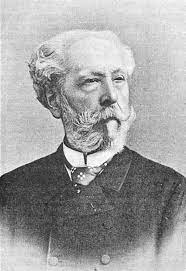Édouard-Victoire-Antoine Lalo was born on January 27, 1823, in Lille, France. A prominent composer of the Romantic era, Lalo is celebrated for his distinctive compositions that merged French lyricism with bold orchestral colors and forms. His contributions to the symphonic and chamber music repertoires remain influential, though his recognition came relatively late in his life.
Early Life and Education
Édouard Lalo hailed from a family of Spanish descent that had settled in Lille. His father was a military officer, and Lalo was exposed to music early on, displaying a precocious talent. At the age of nine, he began studying violin and composition. In 1833, Lalo entered the Lille Conservatoire, where he studied violin with Baumann and composition with Joseph Müller. His early education provided a solid foundation in classical techniques, which he later expanded upon in Paris.
Lalo moved to Paris at the age of sixteen to further his musical training. He entered the Paris Conservatoire in 1840, studying under François Antoine Habeneck, a pivotal figure in French music who greatly influenced Lalo’s violin technique and musical style. Despite the rich cultural environment, Lalo found the Parisian musical scene resistant to new talent, making his initial years in the city challenging.
Early Career and Struggles
In the early stages of his career, Lalo primarily worked as a violinist and a teacher to sustain himself. He performed with the Armingaud Quartet, a group known for its dedication to chamber music, which was relatively underappreciated in France at the time. His involvement with the quartet spurred his interest in composing chamber music, leading to the creation of his early works, including piano trios and string quartets.
Despite his talent, Lalo’s works faced neglect from the Parisian musical establishment, which favored more established names. His music, characterized by its innovation and boldness, did not conform to the conservative tastes of the period. This led to limited performances and recognition during the early years of his career.
Breakthrough and Later Works
Lalo’s major breakthrough came in 1874 with his “Symphonie Espagnole” for violin and orchestra, Op. 21, composed for the famous Spanish violinist Pablo de Sarasate. The work, notable for its rich orchestration and incorporation of Spanish folk themes, garnered significant attention and acclaim, establishing Lalo as a composer of note. “Symphonie Espagnole” remains one of his most performed and recorded works, celebrated for its brilliant violin passages and vibrant orchestral colors.
Following this success, Lalo continued to compose significant works that further solidified his reputation. His Cello Concerto in D minor (1877) and Violin Concerto in F minor (1874) showcased his mastery in balancing soloistic brilliance with orchestral depth. The Cello Concerto, in particular, is renowned for its dramatic intensity and lyrical qualities, becoming a staple in the cellist’s repertoire.
Lalo’s only opera, “Le roi d’Ys,” premiered in 1888, represents another pinnacle of his career. The opera, based on the Breton legend of the submerged city of Ys, was initially rejected by the Paris Opéra but later achieved great success at the Opéra-Comique. Its lush orchestration, memorable arias, and dramatic storyline contributed to its lasting popularity, and it is regarded as a significant contribution to French opera.
Style and Influence
Édouard Lalo’s music is characterized by its vibrant orchestration, innovative use of harmony, and incorporation of folk elements. He was influenced by Spanish music, evident in “Symphonie Espagnole” and other works, reflecting his cultural heritage. Lalo’s compositions often feature a lyrical yet dramatic style, with a keen sense of melody and rhythm that appealed to both performers and audiences.
Although his music did not achieve the widespread popularity of some of his contemporaries during his lifetime, Lalo’s influence can be seen in the works of later French composers, such as Claude Debussy and Maurice Ravel. His emphasis on color and texture, combined with a robust structural approach, contributed to the development of French orchestral and chamber music.
Personal Life and Legacy
Édouard Lalo married Julie de Maligny in 1865, a singer who provided significant support and inspiration throughout his career. His son, Pierre Lalo, became a noted music critic, furthering the family’s musical legacy. Lalo’s later years were marked by a decline in health, but he continued to compose and revise his works until his death on April 22, 1892, in Paris.
Despite the initial challenges and late recognition, Édouard Lalo left a lasting legacy in the realm of classical music. His contributions to the violin and cello repertoire, along with his vibrant orchestral works, have secured him a respected place among the composers of the Romantic era. Today, Lalo’s works are celebrated for their boldness, innovation, and the unique voice he brought to French music.


Comments are closed